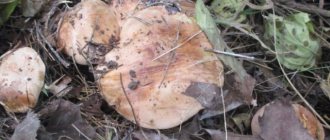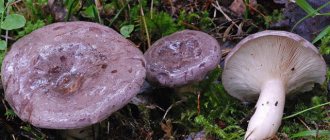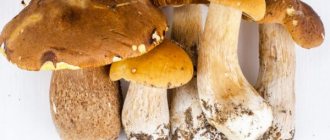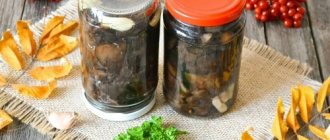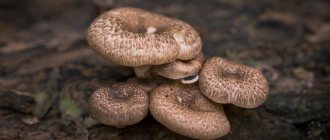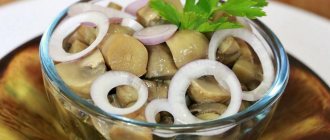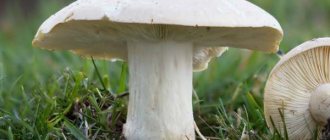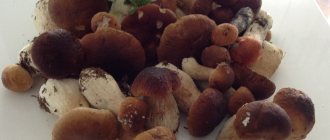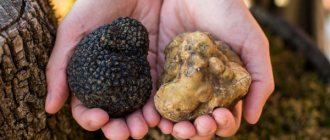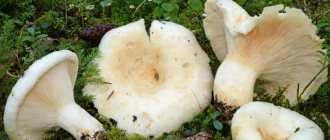Poplar row, what a mushroom looks like: description and photo
People call the mushroom differently, despite the officially accepted name - Poplar row. Alternative options for nicknames remain: poplar, poplar, boletus (unknowingly), sandpiper, frost, zabaluika. Mushroom culture refers to a variety of rows, a subcategory of conditionally edible mushrooms. Eating is allowed after thorough cleaning of forest contaminants, washing and double boiling, with the broth drained after each boiling of water.
Like other mushrooms from the Rowaceae family, it germinates in groups from mid-late August to early November. Depending on the region of fruiting and weather conditions established at the time of collection, the timing of fruiting may vary, deviating forward or backward by 2-3 weeks. It is found only in deciduous forests where poplars and aspens grow. They prefer sandy soil that remains loose even during drought. Quite often it covers large areas.
At a young age, the mushroom cap has an elongated shape, resembling a hemisphere. Over time, closer to the mature state, it straightens, reminding mushroom pickers of an uneven flat pancake, reaching a diameter of 8 to 22 cm. The edges are uneven and slightly wavy. When overripe, they have slight cracks along the edges and even tears. The skin is brown or brownish-yellow, acquiring a reddish tint over time. Pink and reddish tints, lighter from the edge, are allowed. Smooth and slightly silky to the touch, without roughness or scales. The pulp is dense.
The plates differ from the color of the cap. In the first days of formation, they are colored light pink or snow-white, then darken, reaching a rich brown color.
They reproduce using a controversial method.
The lower part or stem of the mushroom is wide and strong, inferior in diameter to the cap. In adulthood, it grows to 9-10 cm, reaching a girth of just over 6 cm. It has a cone-shaped expansion at the base. The color scheme is white or cream.
A special feature of cottonwoods at the time of germination is their camouflage on the ground. Poplar row hides under the cover of fallen leaves, forming small tubercles. To detect a mushroom, a lover of quiet hunting should show maximum care and concentration.
Important!
If you find a single mushroom, you should not leave the collection site. Experienced mushroom pickers recommend squatting down and looking around. A “herd” culture always germinates in families, forming wide circles and intertwining rings.
Varieties of floodplain
Sandpiper is a type of rowing. It has a lot of popular names, but they are mainly associated with its ability to grow near poplars. He is called:
- poplar (poplar) row;
- floodplain;
- poplar;
- sandpiper;
- sandstone;
- subfuel;
- pampering;
- frosty
Sandpipers prefer steppe areas. The most common types of sandpiper:
- grey;
- red;
- greenfinches.
The names of the varieties of floodplain reflect the color of their caps. The bright colors stand out against the pale flesh. The most difficult to find are gray sandpipers - they easily hide among the fallen leaves of poplars.
Where does the poplar row grow, places of germination
Podtopolnik, like most row trees, sprouts in large families, forming full-fledged plantations of a large harvest. In rare cases and during periods of drought, it occurs alone. Fruiting occurs at the end of summer and continues until the end of October - mid-November, depending on the climatic characteristics of the region. In the southern regions, collection continues an order of magnitude longer than in the central and northern regions.
Many people compare poplar with honey mushrooms. Over the course of several years, the mycelium grows over kilometers, forming strong mycorrhiza with deciduous trees. Despite the name, it is found not only in places where poplars grow, but also in aspens, which are related trees in biology. Prefers crumbly, dry soil that dries easily and allows moisture to pass through. The peak of fruiting is considered to be two months: September and October.
Encyclopedias studying the science of Mycology note extensive germination of fungi, both in the former countries of the USSR: Russia, Ukraine and Belarus, and in European countries, Central Asia, North America and Canada. In the warm season it also grows in the vicinity of the Far East.
Cooking rules
At the first stage of processing the poplar row, it is mandatory to soak the fruiting bodies cleared of forest debris in cold tap water for three days. It is necessary to change the water daily, a couple of times, which not only helps remove bitterness from the pulp, but also allows you to remove dirt and adhering forest soil. The container with soaked mushrooms should be placed in a cool room, at a temperature of no more than 13-15°C.
Prepared, peeled or soaked mushrooms can be used to prepare a variety of dishes, including soups, hot and cold appetizers.
Edible or poisonous, can you eat it?
Many novice mushroom pickers who doubt the edibility of the poplar row quite often wonder whether the mushrooms are edible or not. It has been scientifically confirmed that poplar belongs to the category of conditionally edible mushrooms that require preliminary heat treatment, including: cleaning of sand and leaves, rinsing under running water, double or even triple boiling, with the broth drained 5 minutes after boiling.
When germinating in an unfavorable place for collection: a city park, near a highway, a garbage dump or an industrial area, the mushroom is able to absorb toxins and carcinogens into its pulp that can harm the body as a whole. To avoid poisoning and intoxication, you should prefer the nearest forest zones, distant from the city. Do not neglect the rules for preparing the pulp for further preparation of the recipe you like. It is worth devoting maximum time and effort to preserve the nutritional value, taste and aroma of the mushroom product.
Cooking is necessary to remove the bitter aftertaste from the fruit pulp. In comparison with milk mushrooms, the bitter taste of poplar rows can only be removed by heat treatment, which includes repeated boiling. Soaking in salted water will not solve the problem!
Growing floodplains
Podtopolnik can be grown artificially. The main condition for growth is suitable temperature. Fruiting bodies begin to grow only when the temperature drops to 15 °C. There are two options for growing - outdoors and indoors.
Growing outdoors
It is technically easier to grow the mushroom outside. Bookmarking begins in May. The crop is placed in boxes or bags with substrate and laid out on beds. As a substrate you can use:
- peat;
- land;
- soil for plants.
For 5 kg of soil add:
- chalk – 100 g;
- water – 1 l;
- mycelium (vegetative body of mushrooms) – 50 g.
Further procedure:
- After mixing the mixture, place it in prepared containers.
- Sprinkle wet soil on top. Cover with film. Ideal conditions for mycelium are high humidity, air circulation and a temperature of 20 °C.
- After the soil has become overgrown with mycelium, the film is removed. The substrate is placed in the shade. The first fungi will appear 5-6 weeks after planting.
Mushrooms are afraid of frost. Before their onset, it is necessary to cover the mushroom “vegetable garden” with straw, grass, and leaves.
Every time, after collecting another batch of mushrooms, the soil is watered. Or add moist soil - this is even better.
Growing indoors
To grow a decent poplar crop indoors, you need special conditions:
- high humidity;
- temperature regime in the range of 12-15 °C;
- constant ventilation;
- natural light;
- moistening the substrate;
- Sprinkling the mycelium with damp soil.
Podtopolnik is considered a tasty mushroom that is not difficult to find or grow yourself. It is also popular and in demand in many countries, which makes its cultivation profitable.
0
0
Copy link
Taste and aroma
Despite the delicacy of the mushroom, the poplar row is classified as the third and sometimes fourth category of edibility due to the lack of a characteristic mushroom aroma and taste. Woody and nutty notes make the pulp of the protein product unique, retaining its taste even after cooking, provided you follow the step-by-step instructions described in the recipe.
The presence of pungency and bitter aftertaste in cooking is removed by boiling. Double or triple boiling removes all the imperfections from the flesh of the caps and stems, which often frighten off novice mushroom pickers.
The row is white and brown. Inedible rank and file
The following types of rows fall into the category of inedible mushrooms:
- white-brown (white-brown);
- broken;
- stumpy;
- rough;
- soapy;
- dark;
- different (separate);
- sulfur (sulfur-yellow);
- pointed.
On our territory, broken, rough, dark and isolated species are extremely rare. Let us consider in detail the common inedible species:
- The white-brown row has a flattened cap with a tubercle and wavy edges. The surface is mucous. It may have a wine brown or reddish brown hue. Dark veins are visualized across the entire surface of the cap. The edges are pale. There is always a white spot on the velvety pinkish-brown leg. The pulp is white and smells like flour.
White-brown row
- The honey-shaped row has a convex cap with wavy edges. The surface is fibrous, heterogeneous in color. The color is represented by veins and spots of the following shades: red;
- yellow;
- olive;
- brown. The plates of the fungus are intertwined and covered with dark spots. There is a woolly ring on the leg. Above it, the surface of the leg is beige, and below it is white with brown scales.
Ryadovka acumenia
Sulfur row
Soap row
Useful properties and contraindications for use
Like most mushrooms, the Poplar variety contains more than 90% water in its pulp. The remaining percentage is taken up by vitamins, minerals and macroelements necessary for the body to function properly. Mushroom pulp is rich in protein and fatty amino acids, which can replace the consumption of meat in volume. In addition, poplars are considered a dietary and lenten product, widely used as an ingredient in the daily menu during diets and Orthodox fasting.
Calorie content per 100 g is no more than 21 kcal. Depending on soil fertility and moisture level, the indicator fluctuates 2-3 scales up or down. The composition is distinguished by its rich content of the following elements:
- vitamins A, B and C;
- vitamin D2, D7;
- calcium;
- gland;
- potassium;
- manganese;
- phosphorus;
- copper;
- zinc;
- Selena;
- glucose and sucrose.
Mushrooms have antibacterial, antiviral and immunomodulatory properties, therefore they are widely used in pharmaceuticals. The pulp is used to create medications prescribed for the treatment and prevention of various diseases.
It has been scientifically proven that small consumption of poplar row has a positive effect on cardiovascular activity, brain function and gastrointestinal tract. In folk medicine, many recipes based on pulp are considered that can improve gastric secretion, speed up metabolism, removing accumulated toxins and heavy metal poisons from the body.
Mushroom-based decoctions have a positive effect on the functioning of the liver and nervous system. With proper use of tinctures, positive dynamics are observed in both adults and elderly people who have no contraindications.
Potopolnik should be used with caution by people who have the following clinical picture:
- chronic gastritis, peptic ulcers;
- improper functioning of the gallbladder;
- diabetes mellitus, congenital or acquired;
- acute pancreatitis;
- cholecystitis;
- polycystic kidney disease and renal failure;
- after heart attacks and strokes.
It is strictly contraindicated to include mushrooms in the diet: for pregnant women at any stage, women during lactation, children under 12-13 years old, people with individual intolerance or an allergic reaction.
Mushroom value
Poplar row is low in calories, and its chemical composition is similar to meat. It contains a lot of polyunsaturated fats, so it is considered a dietary product. Caloric content of 100 g of product is 24 kcal. The row contains:
- Water – 94.5%.
- Proteins – 3.66%.
- Fats – 0.77%.
- Carbohydrates – 1.56%.
- Vitamins A, C, group B, PP.
- Minerals – selenium, potassium phosphorus.
- Organic acids. There is a lot of citric, tartaric, and oxalic acid in the row.
- Enzymes that break down fats and glycogens.
Poplar row is in demand in pharmaceuticals and cooking. The row is low in calories, so it can be used for dietary nutrition. Vegetarians value it as a source of protein.
When to harvest or peak yield
In the scientific literature, fruiting of the mycelium is described from mid-late August to the end of October. However, as the experience of most mushroom pickers and real reviews left on forums and social media groups shows, fruit formation varies, deviating by 2-3 weeks from the stated period. Depending on the climatic characteristics of the region and the weather, the timing may change, going both forward and backward. You can find out for sure whether there are mushrooms in the forest today by studying the latest information left in the discussions of mushroom pickers. This trick will not allow you to leave the forest without a harvest, saving time on empty wanderings in search of a miracle.
The peak yield of poplar rows usually occurs in September and October. You can discover conditionally edible forest gifts a week after the rain. In most cases, mushrooms hide under the leaf cover, forming small bulges. To notice the prey, the mushroom picker should look closely, removing the top layer of the flooring with his hand.
Unfortunately, poisonous snakes and ticks are found in many parts of our country. To protect yourself, you should dress appropriately, preferring rubber boots to sneakers, and closed clothing, which includes accessories in the form of a headdress, gloves and a backpack. No fragility, collection in buckets, baskets and deformable items of inventory is allowed: backpack, bag, sack.
Rules and meeting places
Experienced mushroom pickers always adhere to the basic rules of mushroom picking. They consist of the following points:
- You can collect mushrooms only in environmentally friendly areas. It is better to stay away from highways and industrial facilities.
- Before collecting, it is necessary to carefully study the appearance and features of the rows so as not to confuse them with inedible doubles.
Mushroom picking - The harvest is collected in baskets and boxes. Cellophane bags cannot be used.
- To save time and space in the basket, the mushrooms found are immediately inspected for worminess.
- The most optimal time of day for mushroom pickers is considered to be the morning, when drops of dew sparkle on the caps.
- The floodplains cannot be torn; they must be cut using a sharp tool, preferably a knife. A broken place in the mycelium can destroy the entire mushroom family.
- Even experienced mushroom pickers never put a mushroom in a basket that has caused even the slightest doubt.
It is better to collect floodplains when they are young. This species is characterized by hyperactive absorption of elements from the external environment, so in old individuals the fruiting bodies can be toxic. You can find poplar rows under poplars. Mushrooms always grow in large groups and in a row. However, it is sometimes difficult to find them, because the rows tend to hide under fallen leaves and burrow into the soil.
Features
It is not difficult to identify a poplar row in front of you, knowing the distinctive features that distinguish a conventional mushroom from false analogues belonging to inedible and poisonous subcategories.
4 signs of edibility:
1) the aroma resembles the smell of tree bark with notes of hazelnut and fresh flour; 2) can germinate only in poplars and aspens; 3) the color scheme can be light, closer to a cream or grayish tint, but not snow-white; 4) absence of convexity in the center of the cap.
Similar species
The poplar row has only a few doubles.
- The row is crowded. The similarity appears only in young fruiting bodies. Poplar is distinguished by its larger size and bitter taste.
- Tiger row. You can distinguish them by their place of growth. Potopolniks grow only under poplars and large families.
False poplar rows, varieties in the photo
- No. 1 - Chanterelle
Despite the fact that mushrooms have different colors, many beginners who are poorly versed in mycology may confuse mushrooms with each other. To understand what a fox looks like, you should look at the photo below.
- No. 2 - Crowded row
Very similar to poplar in color and structure. The following signs allow you to distinguish another conditionally edible mushroom: an unpleasant, slightly repulsive odor, translucent thickened flesh.
- No. 3 – Ryadovka Tiger
One of the poisonous representatives of the mushroom world, especially dangerous for consumption even in small quantities. It has dark brown scales on the caps, visually reminiscent of the effect of cracking.
Important!
In order not to confuse the sandpiper with its false brothers, you should pay special attention to the color scheme and aroma of the mushroom. Inedible analogues are always given out by a non-standard color or an unpleasant odor, causing disgust from the cut prey.
Contraindications
You should be careful when choosing a place to collect mushrooms. The pulp of poplar row actively absorbs all environmental pollutants. Therefore, you should refuse to consume them as food if the mushrooms grew within the city limits, roads and landfills. It is also worth discarding overripe specimens and harvesting exclusively from young fruiting bodies.
People with the following diseases should avoid eating mushrooms:
- cholecystitis;
- gallbladder dysfunction;
- gastritis and stomach ulcers;
- chronic disorders in the gastrointestinal tract;
- pancreatitis.
It is also worth avoiding consumption by pregnant and lactating women, children under 7 years of age, and people prone to allergic reactions.
An overdose of floodplains is expressed by flatulence, diarrhea, heaviness in the right hypochondrium, and cramps in the stomach.
INTERESTING: The unfavorable environment gives poplar a slightly bitter taste. In order to get rid of it, they are soaked for a long time in cold water.
Recipes for preparing poplar rows step by step at home
The delicious taste characteristics of poplar are well conveyed in various dishes and preparations for the winter, provided that step-by-step instructions are followed and the recipe is followed. Before cooking, prolonged heat treatment is necessary to remove bitterness from the pulp.
How to clean correctly, tips + instructions
Germination of foliage under infusion on sandy soil involves the removal of forest contaminants immediately after collection. For better removal of sand, mushrooms are soaked in cold water for several hours, beginning with washing and cleaning after the procedure is completed.
Turning the mushroom upside down, clean the plates of dirt using a knife. There should be no grains of sand remaining in the cuts, which shorten the shelf life of the preparations for the winter, affecting the taste and tenderness of the pulp.
Cleaning step by step:
1) the lower layer (cut) of the leg is cut off by a few mm, checking the pulp for worms and the process of rotting. If there is damage, remove the affected areas or throw the unusable product into the trash bin;
2) if there is no extra time left for the soaking process, they prefer cleaning with a small brush with soft bristles that penetrate deeply into the plates;
3) the skin of the cap is scraped off with the sharp side of a knife, rinsing the finished mushroom under running water.
Helpful advice!
You can reduce cleaning time by dry cleaning. Sunflower oil is dripped onto the bristles of the brush and passed over both the outside of the stem and cap, and the plates. After boiling, the oily layer is removed with any remaining impurities, allowing the pulp to be used for further cooking.
Soak or not
Many mushroom pickers never tire of arguing about soaking poplar rows in a salted solution. Some claim that prolonged exposure to salt water removes the bitterness characteristic of poplar, while others insist on boiling with the addition of table salt. The answer to a question that interests many lies in the availability of free time and the endurance of the cook. Unlike milk mushrooms, conditionally edible sand lances are less able to remove bitterness from the taste and in order to remove the negative property, the mushrooms will have to be soaked for more than a day. At the same time, every 4-5 hours, it is necessary to drain the water, adding new water and adding salt. The multiple boiling process reduces waiting time from 48 hours to 60-80 minutes. Therefore, the choice in favor of the second option is obvious.
If you want to pickle poplar rows using a cold method or pickle them according to one of the pickling recipes for the winter, you should give preference to soaking. Long-term exposure to cold water will maintain a dense consistency, allowing you to further add crunch and spice flavors.
Soaking time is from 48 to 72 hours. If possible, you should change the water 4-5 times a day, not forgetting to sprinkle the fruits with salt. The water temperature should not fall or rise above 14-15 degrees Celsius to prevent fermentation.
You can determine readiness as it soaks by the structure of the large mushroom. If it has become elastic and does not fall apart when pressed, then there is no more bitterness in the poplar.
How long to cook poplar
Poplar row does not require long cooking. Double or triple boiling involves boiling the mushrooms for 25 minutes, draining the broth before the next time. Cooks wait until it boils, reduce the temperature and boil the mushrooms for no longer than 2-3 minutes. Then, tip the pan through a colander, rinsing the pan and mushrooms, repeating the previous step. After the third boiling, the mushrooms are washed and dried on a flat surface to prevent excess moisture from entering the future recipe.
The housewife can choose the further recipe at her own discretion, focusing on the tastes of her household and the availability of free time. If possible, it is allowed to divide the total mass into 2 dishes.
How to cook correctly - tips
There are no restrictions on choice! Cooks can choose any dish they like at their discretion. The most important thing is to follow the step-by-step recipe without violating the volume of ingredients and recipe. A lack of seasonings and spices, as well as too much, will spoil the taste and not live up to initial expectations.
4 tips for preparing poplar rows:
1) do not overdo it with fat. Frying and preservation should be carried out with a minimum volume of sunflower and butter;
2) spices and herbs are added to any dish in a minimal amount so as not to overshadow the woody and nutty aroma;
3) cooking soups and hot dishes does not exclude heat treatment. Double boiling is mandatory;
4) boiling for too long will turn the mushrooms into a porridge-like mass. To prevent overcooking, you should boil poplar poplars for no longer than 20 minutes each time.
Pickling poplar row - detailed recipe
To get delicious pickled mushrooms after returning from the forest, you should devote a sufficient amount of time to pre-processing, soaking or boiling.
Products:
- 2.5 kg rows;
- 2.5 table. l. table salt and sugar;
- 5 table. l. table vinegar 9%;
- 900 ml of water (mineral without gas is possible);
- a whole head of garlic, divided into cloves and peeled;
- 6 laurel leaves.
1) Mushrooms prepared for preservation are put aside, paying attention to preparing the marinade.
2) In a pan of suitable size, prepare the filling. Add salt and sugar, pour in water and turn on the burner. After 10 minutes, add the mushrooms and boil for another 10-15 minutes. Next, pour in the vinegar, mix well and remove from the heat.
3) Place the following in pre-sterilized jars: garlic cloves and bay leaves, add mushrooms, leaving a free space two fingers wide.
4) Pour the marinade and screw on the lids using a preservation key.
As a method for sterilization, choose a water bath, microwave and oven. The procedure is performed for 10 to 15 minutes, not forgetting about the lids.
Important!
Metal lids cannot be sterilized in the microwave!
Pickling or fermenting poplar rows - the simplest and easiest recipe
The presence of a cellar or a cool room for pickling, an oak barrel and the presence of poplar trees, allow you to prepare amazing crispy mushrooms with woody and nutty notes. To repeat the recipe, the following proportion is observed: 45 g of salt per 1 kg of boiled mushrooms. Seasonings and spices are visible to the eye in small quantities.
The mushrooms are placed in an oak container in layers, sprinkled with salt, spices and fresh herbs, cherry, currant, oak and horseradish leaves. Place a lid or plate with wide brims on top and apply a press. Leave the workpiece for 1-1.5 months.
Important!
To prevent mold from forming, sprinkle ground cinnamon or mustard over the surface. Some cooks pour 2-4 tables. l. butter, forming a dense oily film that protects the workpiece from bacteria and microorganisms.
Marinating poplar in tomato juice
The most delicious preparation for the winter is obtained by combining delicious mushrooms with tomato juice.
- Boil 1.5 liters to a boil over low heat, adding salt, sugar, spices and 30 ml of table vinegar as cooking progresses.
- Boil the mushrooms in a separate pan, following the rules of heat treatment.
- Place the mushrooms in sterilized jars, fill with juice and seal with lids.
- The finished preserves are stored in the refrigerator for no longer than 3 months.
- To ensure that the mushrooms are soaked, you should not try the poplar row earlier than a month from the date of conservation.
Poplar row: how to fry and with what
To get a delicious main course for dinner, it is recommended to choose the following dishes:
- potatoes with mushrooms and sour cream;
- vareniki;
- vegetable stew with poplars;
- homemade roast;
- cutlets;
- frying based on onions and carrots;
- buckwheat porridge with poplar row;
- warm salad with fried mushrooms.
After heat treatment, the mushrooms are chopped and fried in vegetable oil until golden brown on each side. Salt and spices are added at the end of cooking so that the water evaporates faster.
How to assemble a floodplain correctly?
To ensure that the mushroom “catch” is plentiful and healthy, follow the collection rules:
- Do not take poplar trees growing along highways - they absorb exhaust emissions. Walk at least 1.5 km into the forest.
- Follow the rows in cool, clear weather. It is advisable that it rained the day before - then the “catch” will be more generous.
- Bring a stick - sandpipers love to hide, so you will have to rake away the leaves and top layer of soil.
- Don’t forget that next to one poplar tree there will definitely be others. It happens that in one place you can collect a full basket.
Inexperienced mushroom pickers often mistake the wavy-legged mushroom, which can cause indigestion, for the tortoiseshell. To avoid making a mistake, do not look for poplar trees under coniferous trees.
Watch the video - a hike behind the rows. An experienced mushroom picker will tell you how and where to look for them, how to collect them and cook deliciously:
Real reviews + photos
- Elena Igorevna, 39 years old
Every autumn, poplar rows are collected in the aspen planting. It turns out to be more than a bucket in one trip. If you are lucky with the weather, you can collect more fresh, worm-free fruits. Poplars are the tastiest preparations for the winter. I prefer hot marinating.
- Victor Vasilievich, 75 years old
I used to not understand what people found in the taste of poplar row, until they taught me how to cook it properly. My mistake was short soaking. Now, if there is not enough time, I boil it, and then ferment it or seal it in jars in a cold way.
Despite its conditionally edible origin, the Poplar row mushroom, if you know the description and photo, is easily identified and brings maximum benefits to the body. Recipes based on fruits include mandatory pre-processing and boiling, sometimes soaking.
Features of taste
The poplar mushroom belongs to the edible category, but the characteristic taste of the pulp requires mandatory pre-treatment of the fruiting bodies in order to remove specific bitterness. As a rule, specimens with the most bitter pulp grow under silver poplars.
Such mushrooms require especially careful boiling or prolonged soaking. It should be noted that even during a very long cooking process, the mushroom pulp of the poplar is able to maintain a fairly dense consistency, therefore the fruiting bodies of this type of row are especially highly valued among lovers of “elastic” mushrooms.
Blue mushrooms. Bluelegged mushroom or lilac-legged row mushroom.
Among the numerous family of mushrooms, there are some varieties that are memorable and unlike anything else. These include the lilac-legged row.
It is also called: blue-legged, blue root, two-color row, lilac-legged lepista. This is an edible mushroom of the Lepista genus, of the Ordinaceae family.
WHAT IT LOOKS LIKE:
Hat: Up to 17-20 cm in diameter, cushion-shaped, smooth, yellowish-beige with a purple tint.
Laminae: frequent, free, wide. Their color is yellowish or cream.
Leg: Up to 10 cm long and up to 3 cm in diameter. Interestingly, its appearance changes with age. In young mushrooms, a fibrous structure of the stem is visible, covered with flakes (remnants of the private covering). In adult mushrooms it becomes smooth. Its color, almost like that of the cap, is grayish-violet, but sometimes it can be bluish.
Pulp: young mushrooms are dense and thick, becoming looser with age. Its color can be light purple, grayish or gray-violet with a mild sweetish taste and a light fruity aroma. But not everyone likes this! It’s unusual to somehow taste mushrooms with a fruity aroma!
WHERE IT GROWS:
Bluefoot loves soil with a high humus content, so it often grows near areas of livestock grazing and human habitation, on old heaps of manure and compost. It is often found in forests, preferring deciduous trees.
These mushrooms bear fruit in large families, in rows. They often form “witch rings” of impressive size. In the southern regions of Russia from early May to November. In the middle zone they grow, most often, only in the autumn.
Purple-legged row mushrooms are very resistant to cold weather. Their growing season can continue even when you can no longer find other mushrooms. They can withstand even light frosts down to 3-4 degrees.
Edibility:
Quite an edible category 4 mushroom. It can be salted, fried and pickled. Some gourmets claim that when pickled, it tastes like pickled honey mushrooms. I can neither confirm nor deny this. I didn’t have to eat pickled rows!
THANK YOU TO EVERYONE WHO READ!
